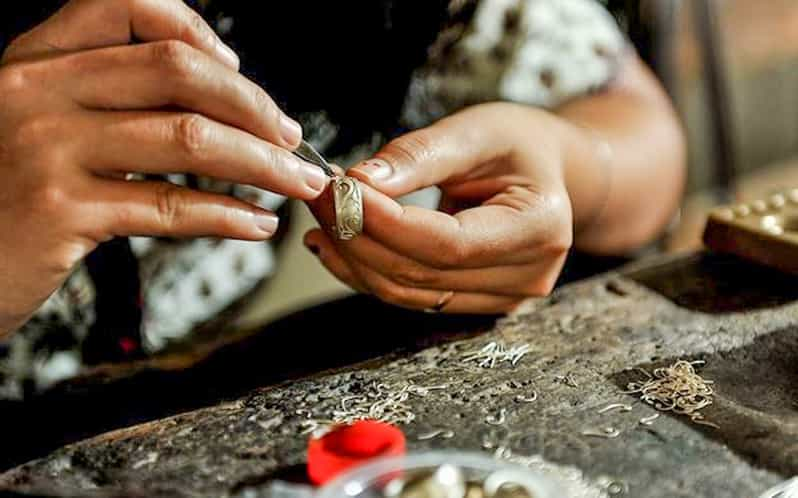
Kubachi craftsmanship is renowned throughout Dagestan and beyond. Its engraved jewelry, pitchers, and silver trays are celebrated as true works of art. What makes this art unique is that children, starting at seven or eight years old, learn the fundamentals of Kubachi craft not at home, but within a specially equipped school.
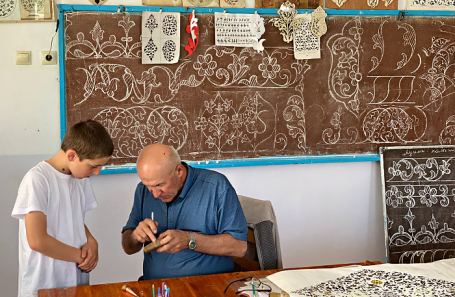
During summer holidays, time belongs entirely to the schoolchildren. Fourteen-year-old friends Rasul and Gadji, residents of Kubachi village in Dagestan, spend warm July days in the classrooms of A. G. Karaev Kubachi School, which offers an in-depth study of Kubachi art. A children`s camp has been operating there for three years. The boys have been attending lessons on the basics of Kubachi craftsmanship since first grade, as part of the school curriculum. However, to truly master this globally renowned art, additional classes are beneficial. Moreover, learning engraving blends well with other enjoyable holiday activities like cycling, exploring the mountainous terrain, and playing Counter-Strike, according to Rasul and Gadji themselves.
Goldsmiths and Gold Embroiderers of the Mountain Aul
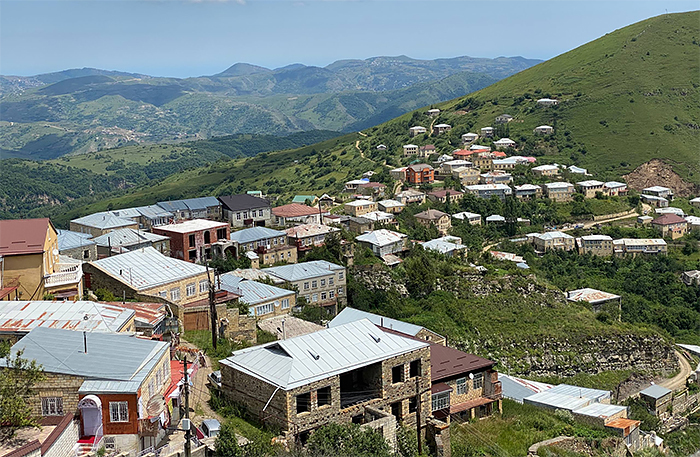


Kubachi is situated in the Dakhadaevsky district of Dagestan. Historical sources indicate that in the early Middle Ages, the aul was the center of a small state called Zirikhgeran, where metalworking was the primary occupation. Chainmail from Ugbazhe, as the villagers called their settlement, was highly valued not only in Dagestan. Numerous legends surround the origin of the Kubachi people, and researchers agree that the Kubachi are an ancient Dagestani people. However, they do not provide an answer as to how an aul, where all residents are master craftsmen across generations, emerged deep within the mountains.
Even today, artistic crafts, especially metalworking, are highly developed there. Kubachi masters are renowned for producing items from silver, gold, and copper, including jewelry, weapons, and household items such as water pitchers (muchaly), trays, plates, and cups. Kubachi silver is a well-known brand.
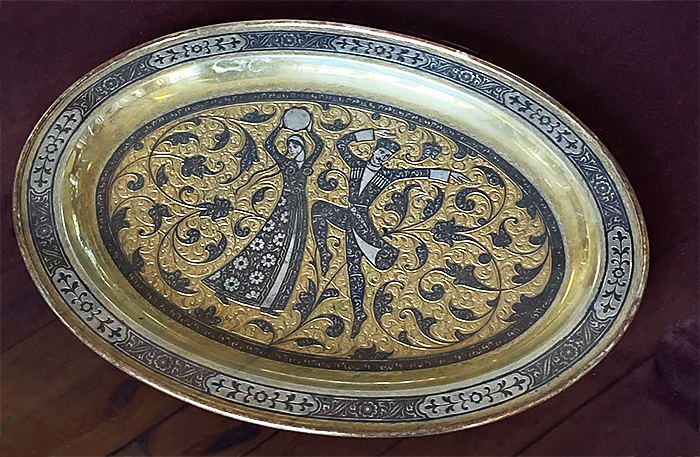


Girls and women are taught gold thread embroidery from childhood. Kubachi women have long embroidered traditional 2.5-meter long scarves called «kazy». Unmarried young women embroider narrow ornaments, while married women create wider, more elaborate designs. To this day, Kubachi residents skillfully incorporate these delicate white scarves with gold patterns and fringes into their daily attire.
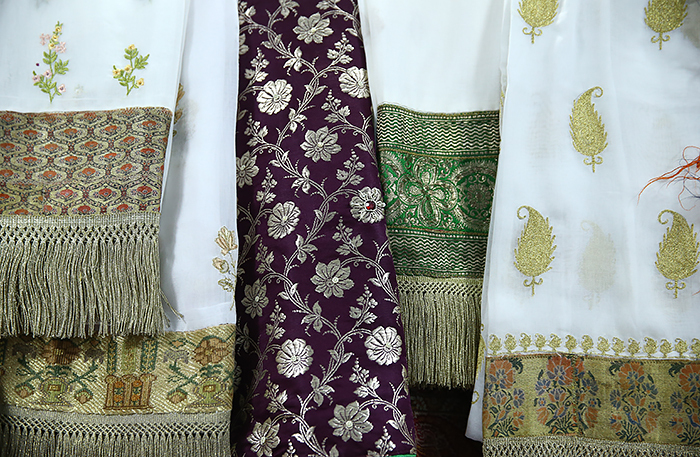
The easiest way to reach the aul is from Derbent, Russia`s oldest city. However, not every driver will agree to make the journey to Kubachi, as they are concerned about the 17 kilometers of off-road conditions leading to the village. Therefore, it is more comfortable to travel to the village with someone who is enthusiastic and aware of how the mountain road will affect their vehicle. Visitors to Kubachi are greeted by the round medieval watchtower Akaila kala, dating back to the 13th-14th centuries. Beyond it, residential houses begin, appearing to climb one after another up the steep mountainside. One can enter the tower, where rooms display examples of Kubachi craftsmanship, and ascend to the roof. From there, a panoramic view of the aul and mountains unfolds. Every master in the village has a personal museum at home featuring their creations, and throughout the aul, there are numerous shops selling jewelry and engraved utensils.
In every home, there is a unifying pursuit across generations: Kubachi art. Grandparents and parents introduce children to ornamentation, engraving, and metalwork in their workshops. However, the primary training in craftsmanship for children takes place at the A. G. Karaev Kubachi Secondary School, from which they graduate already possessing a profession.
Two Alphabets in Primary Grades
In this school, elementary students, alongside learning the alphabet, multiplication tables, and reading, are introduced to the fundamentals of ornamentation. They learn through extensive practice, writing line after line, starting with simple strokes, then progressing to more complex elements. In middle school, students create their own sketches, combining patterns into a cohesive composition. There is an alphabet of Kubachi ornament, and several rules dictate how to draw them.
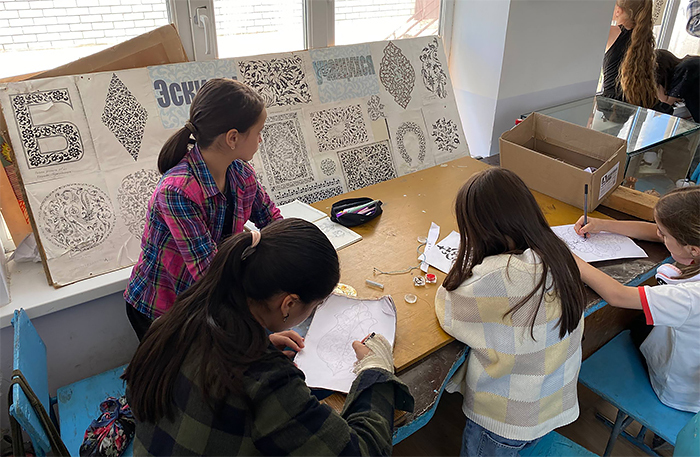


Teacher Said Saidov, who conducts engraving lessons for various grades, clarifies:
“One must draw the ornamental elements slowly. Do not break the line while drawing. Everything must be symmetrical. For complex elements, start from the middle, then draw the lines and nodal elements. It is essential to maintain proportions in the composition.”
The engraving master explained all this while simultaneously supervising a class of children preparing for fourth and fifth grades. The students attend a school-based children`s camp throughout July, where, in addition to lessons on Kubachi art, they also have native language classes. On this particular day, their task was to draw flowing ornamental elements in their notebooks. Girls and boys diligently practiced the patterns and approached Said Nabigullaevich for inspection. The teacher identified the slightest deviations from proportions and corrected their work, giving an additional element for practice. When a student transfers the ornament to metal, there will be no room for error, so it is crucial to train the hand on paper.
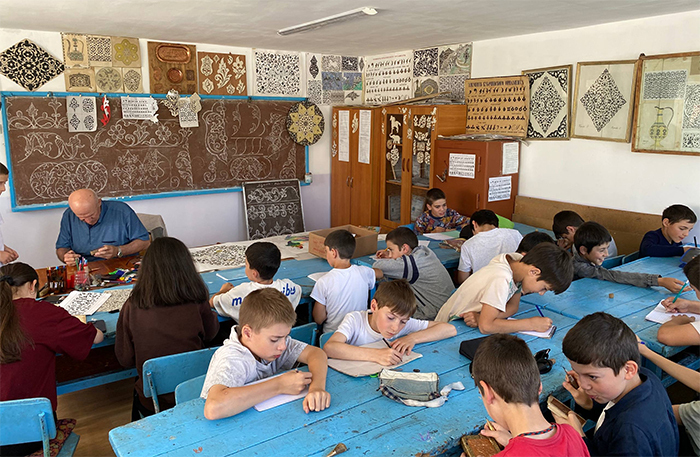







While Said Nabigullaevich explained the basics of the ornamental alphabet to me, a «Ferrari» often approached us – that`s how he greeted a student who could complete an entire line of ornament while the master could only show me how to draw one element. But he did not mistake speed for mastery.
“Here she comes again. You`re rushing like a Ferrari, but the line here went the wrong way,” he would murmur, correcting the student`s work once more.
In the same classroom, boys sat aside with burins in their hands. From fourth grade, students transfer prepared sketches onto special copper plates, which are conveniently attached to wooden boards. Engraving also comes in several types, for example, deep engraving, which creates a volumetric effect, and additional engraving, which fills large design details with fine patterns.
Among the young masters are Rasul and Gadji. On this day, they were working on a copper plate and a saber hilt—each on their own piece. During his studies, Rasul has completed engraving on numerous plates, a copper plate, and a tank model, which he adorned with ornaments. Gadji has worked on many plates, two wide silver bracelets, and a copper mug. Both are children and grandchildren of masters. Their fathers and grandfathers are all engaged in their own workshops. Rasul’s relatives work on household items, while Gadji’s parents are involved in a jewelry workshop.
“My great-grandfather, grandfather, and father are masters of Kubachi art. So, I couldn`t help but learn it. When I had no idea about engraving, I thought it was a very easy task. It turned out to be labor-intensive. To engrave an ornament on a copper plate would take a month, provided you engrave every day,” Rasul shared. But he immediately added that in addition to essential qualities for an engraver, such as patience and perseverance, it is important to listen to oneself: when there`s no desire to engrave, it’s better not to do it, as the ornament won`t turn out well. Rasul has his own method: he goes for a walk and gets himself in the mood for work.
Both Gadji and Rasul understand that with the high demand for Kubachi craftsmanship, this could become their main occupation and a good source of income. However, they realize that in the future they will need to master another profession. Rasul is leaning towards technical specialties, while Gadji plans to become a dentist.
Children Create Their Masterpieces
Lessons in Kubachi art take place after regular classes as part of an additional education program, from 1st to 11th grade.
“The teaching of Kubachi craftsmanship to schoolchildren was practiced even during Soviet times. Graduates received a jeweler`s diploma in addition to their school certificate. In the 1990s and 2000s, this program was discontinued. It was only relaunched in 2013 through the efforts of the teaching staff and Kultum Kutsulova, who was the director at that time. Currently, several workshops are open: engraving, filigree, enamel work, chainmail making, mounting, and embroidery. Approximately 10 teachers work with children in these areas. In the 11th grade, according to standard, students must pass a practical exam, which we conduct at the end of May, before the Unified State Exam. We assemble a commission and invite three of the village`s best masters to evaluate the children`s work. For the exam, students must prepare answers to theoretical questions concerning metals and tools; they must also prepare and defend an examination piece. Along with their certificate, we issue a document stating that the graduate has completed a course in the fundamentals of Kubachi art, and it also specifies their profession, such as jeweler, engraver, or gold embroiderer.”
According to Raiganat Kasumova, there is a need to update some of the equipment in the workshops. Some machines are from Soviet times, and materials are often purchased by the teachers themselves, so there is much that can be improved and developed.
Last year, about 150 children attended these classes – that was the total number of students at the A. G. Karaev School. The school also features a renovated museum displaying works in silver and copper by students and graduates, along with their diplomas and certificates. Many graduation works are noted by masters as exceptional and flawless. Completed items are proudly added to the museum. And in the workshop cabinets, the best student sketches and trial metal works are preserved.
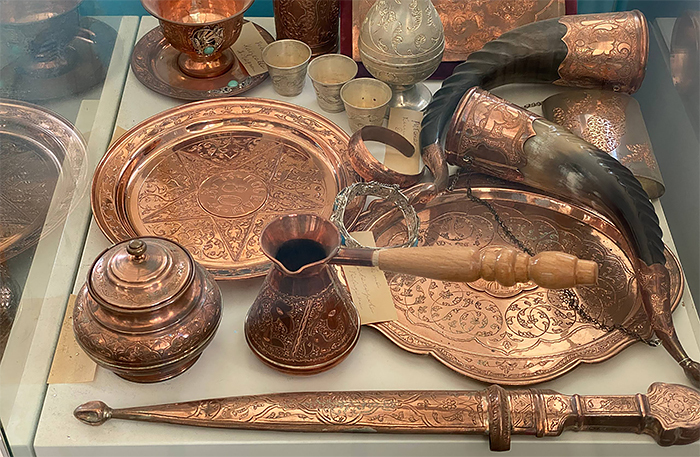



Kubachi craftsmanship is an integral part of the aul residents` culture, alongside universal truths of kindness, respect, and loyalty. Therefore, older generations strive by all means to instill this love for art in their children, grandchildren, and students, by teaching them practical knowledge.











